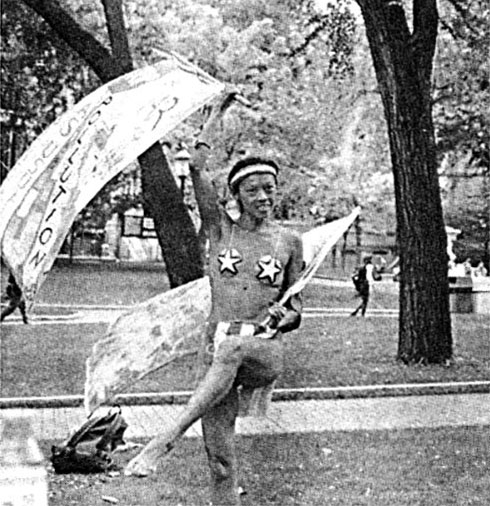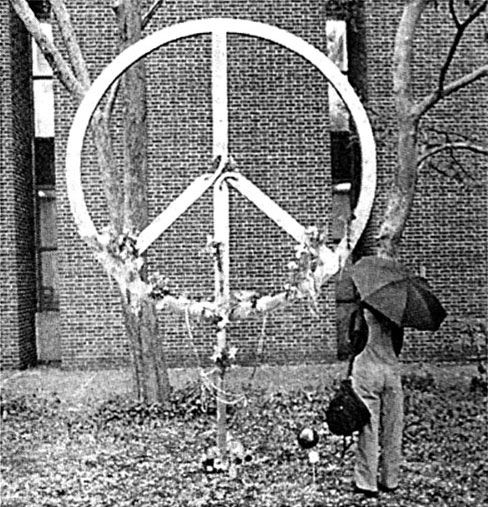Discography | Stage
1974-98 | solid state
Marian Zazeela’s poster for one of the
original performances of Solid State
Performances
March 1998 | MANCA Festival / Nice
February 1997 | Planetarium / Amsterdam
January 1,2 1977 | Merce Cunningham and Dance Company / New York
January 1977 | Museum of Contemporary Art / Chicago
November 5,6 1977 | Walker Art Center / Minneapolis
*May 29-31 1975 | Dia Art Foundation / New York
May 1, 2 1974 | The Kitchen / New York
*Expanded version with Jon Hassell, David Rosenboom,
Richard Teitelbaum and Walter DeMaria performing live.
Paul Hume of The Washington Post described this experience as “a great cloud moving to the center of the room there to hang in an invisible cluster.
Tom Johnson in The Village Voice compared it to “walking around a ‘Henry Moore’.”
John Rockwell in The New York Times found “its dappled color a balm to the ear.”
Alan Artner in The Chicago Tribune discovered “‘holes’ in the dense fabric, pockets of sound that might disappear but five feet away…a musical event of extraordinary richness.”
Performance notes
Solid State is usually described as an “invisible sonic sculpture” which takes place in time. The avoidance of the word “musical” in its initial description is meant to provoke a fresh approach to the event and to the experience of listening, beyond the conventional expectations set up by the notion of a “concert”.
In spite of its creation almost thirty years ago, it sounds as if it could be an ambitious piece of today’s “electronica” movement—something designed to throb viscerally from the giant loudspeakers of a dance club. Around the world—in Contemporary Art Museums in Chicago, Los Angeles, and Nice, the Planetarium in Amsterdam, with Merce Cunningham Dance in New York, Solid State has unfailingly registered with audiences around the world as a powerful psychological/spiritual experience.
Solid State
Classical sculpture began with all its material “given”—a block of stone becomes a form by subtracting that which is already there. With Solid State, holes are “carved” (filtered) out of a block of sound, rhythmically unfolding in time. The rhythm patterns “morph” dynamically and spatially from one to another: for example a pattern of “strong-strong-weak” gradually morphs to “strong-weak-strong” without your being aware of the exact moment of change. (Like the positive/negative space of gestalt diagrams where one form appears as another disappears, demonstrating the impossibility of holding both images in perception simultaneously.)
This brings up the idea of Solid State as an “audialization” (cf. “visualization”) of a complex visual concept—like a computer simulation of a storm which is “performed” sonically instead of visually.
But, more importantly, the Solid State experience is one of poetry and perception. In earlier performances an extraordinary relationship was discovered to a passage from Carlos Castaneda’s A Separate Reality (written two years after Solid State was created):
“(Don Juan said)…that I should focus all my attention on listening to sounds and do my best to find the holes between the sounds… I began to listen and I could distinguish the whistling of birds, the wind rustling the leaves, the buzzing of insects… I was immersed in a strange world of sound, as I had never been in my life… After a moment of attentive listening I thought I understood don Juan’s recommendation to watch for the holes between the sounds. The pattern of noises had spaces in between sounds!… the timing of each sound was a unit in the overall pattern… Thus the spaces or pauses in between sounds were, if I paid attention to them, holes in a structure…
“I shifted my attention from hearing to looking… The silhouette of the hills was arranged in such a way that from the place where I was looking there seemed to be a hole on the side of one of the hills… a space between two hills… It was as if the hole I was looking at was the ‘hole’ in the sound… Then the other sounds began again and their structure of pauses became an extraordinary, almost visual perception. I began seeing the sounds as they created patterns and then all those patterns became superimposed on the environment… I was not looking or hearing as I was accustomed to doing. I was doing something which was entirely different but combined features of both… my attention was focused on the large hole in the hills. I felt I was hearing it and at the same time looking at it.”

